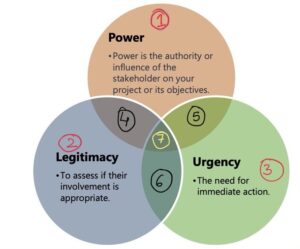Project Management Articles
Salience Model – How to manage stakeholders
The below video describes the salient model in detail.
The Dimensions
Power
- Power is the authority or influence of the stakeholder on your project or its objectives.
Legitimacy
- Legitimacy is if the requirements/interest valid?
Urgency
- Urgency is time bound.
- Check if requirement is time-specific or only fulfilment is important irrespective of time.

Latent Stakeholders
They have just ONE attribute:
1 Dormant stakeholders
- They have power but not urgency or legitimacy.
- A stakeholder from top management of another unit.
2 Discretionary stakeholders
- They are legitimate but have no power or urgency.
- NGOs in construction projects.
- A feedback from your Team Member.
- A vendor asking for specification of new upcoming iphone model
- These stakeholders may ask for few details on the project.
3 Demanding stakeholders
- They are with urgency.
- Think of Assistant to CEO wants some information from your project
- They may create unnecessary drama if needs are not met
Expectant Stakeholders
Combination of TWO attributes:
4 Dominant stakeholders: Power and legitimacy overlap
- Your Boss hierarchy, The government clearance office
- Manage as and when information is asked for.
5 Dangerous stakeholders: Power and urgency
- Local Terrorists/Goons
- Identify these stakeholders and mitigate the threats they pose.
6 Dependent stakeholders: legitimate and have the urgency
- Construction : local residents
- Keep them informed
Core Stakeholders
7. Definitive stakeholders:
- Most important.
- The power, legitimacy combined with urgency
- Customer Top Management
- Your Top Management
- Manage them closely
Non-Stakeholders:
- These are not stakeholders of your project
Benefits of the Salience Model
- It provides you with better insight into your stakeholders information needs.
- It helps you optimize communications and hence resources, time, and effort.
- It helps you manage stakeholders better.
Limitations of the Salience Model
- Complex to follow

